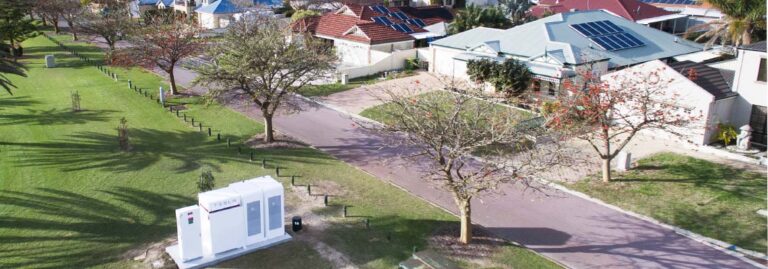
25 May 2022
The election has sent a message to both major parties about strong, local democracy and action on climate change. This is what communities around the country are calling for.
We’ve been hearing this same message over the past few years when we speak with Australians about what they want from our future energy system. There is huge interest in neighbourhood batteries, for example. Disenchanted with policy inaction, communities are seeking to take power into their own hands (and batteries), and to get on with decarbonisation together.
Good then, that Labor promised a $200 million community battery scheme, pointing out on their website, that “it just makes good sense” to share a big battery instead of expecting every household to pay for the purchase, installation and maintenance of their own battery. Indeed, this type of battery storage will reduce the cost of battery storage per house and allow more rooftop solar.
Neighbourhood batteries are a type of mid-scale storage ranging from 0.1 to 5 MW located in front of the meter in the distribution network, connected to a group of households or businesses. The battery may be owned by energy retailers, distribution networks (DNSPs), local councils and community groups or organisations, to provide a wide range of potential services and benefits.
Does the value of neighbourhood batteries stack up?
However, the positive benefits of neighbourhood batteries are not guaranteed. Batteries can decrease emissions, but only if charging from renewables and displacing fossil fuels, i.e. this is not the case if they’re charging from largely coal-powered grid energy overnight.
There’s no guarantee they will improve equity either; emerging models could target opportunities to solar owning households, or retail ‘savvy’ customers, increasing existing inequalities between households rather than fixing them.
In Australia, there is low trust in the energy sector. We also know that trust in project proponents is linked to public acceptability and positive impacts for energy projects. Despite assumptions that what matters most to people is their energy bill, desires for equity, resilience, and rapid decarbonisation are dominant in people’s enthusiasm for neighbourhood batteries, and issues of transparency and accountability foremost concerns.
If neighbourhood battery proponents don’t listen to people and respond to these concerns in their design, there could be significant backlash against the technology. Listening to people is not just a matter of consulting residents living nearby a proposed site (though this is very important).
It’s about incorporating the values they see missing in the energy transition into the design of the business model and battery governance. This is a new paradigm for many in the energy sector who are used to thinking about energy problems in techno-economic terms only.
Our research has found that people want to support decarbonisation and allow more renewables, seeing storage as an essential player in reducing grid congestion and supporting solar generation. Many people want to make energy more local, and are intuitively drawn to the potential to provide local economic value, employ local people, and keep battery profits in the locality.
People also want to know how they can ‘do their bit,’ contributing to reducing or shifting energy use to support the energy transition. In doing so, they want to create a sense of community, building community connections and sharing the benefits of local renewable energy to promote fairness.
The design and operation of neighbourhood batteries is therefore not a straightforward process with one clear solution that will guarantee equally positive impacts for all stakeholders (including the planet). Our previous research, published in Nature Energy, has revealed how neighbourhood batteries can provide a range of positive values, but not all at once.
Choices have to be made about what values the battery generates. It might be helpful for people to think about value balancing, rather than value stacking.
How to ensure people’s hopes and ideals are embedded?
We can make sure at this early stage that we consider different ownership, business model and financing options, and evaluate these in terms of what benefits they deliver, and to whom. These benefits will influence the level of trust that people have in batteries, locally and generally.
People have concerns about ownership by organisations in the energy system that hold a narrow set of concerns, not aligned with the broader concerns they themselves hold. Business models are central because they encode; 1) where the financial benefits flow; 2) how complex it is for householders to participate and 3) whether the battery fulfils decarbonisation objectives.
In the early stages of this technology’s development, it’s also important that we explore a range of financing options and don’t privilege one group over others. We need to keep in mind that financial feasibility will change over time and not get locked into a restricted set of models.
Who is responsible?
Community groups, researchers, policy-makers, and businesses all have a role to play in making sure neighbourhood batteries actually improve our energy system. If policy is to have its intended effect and bring power to the people, the clear message sent out this election must be heard – people want fairness, transparency and effective decarbonisation.
Policy-makers across state and federal levels must engage with communities, embrace diversity and innovation, and evaluate trials and programs to ensure that new technologies are part of a progressive and just transition.
There is an important role for our new Labor government to play in supporting this mid-scale storage technology to achieve its promise, in terms of both decarbonisation and community energy self-sufficiency. This has to be about building capability, not picking winners. We hope that Labor steps up to this role. We’re ready to play our part in providing independent research and analysis to support these exciting developments.
